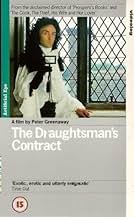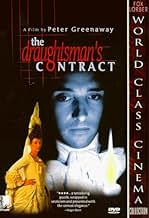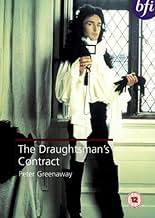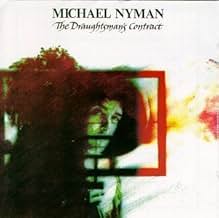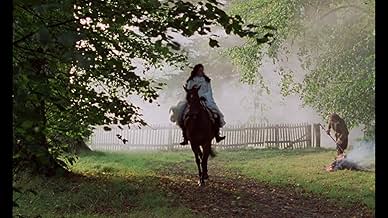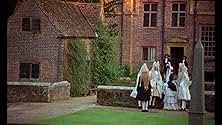IMDb RATING
7.2/10
12K
YOUR RATING
A young artist is commissioned by the wife of a wealthy landowner to make a series of drawings of the estate while her husband is away.A young artist is commissioned by the wife of a wealthy landowner to make a series of drawings of the estate while her husband is away.A young artist is commissioned by the wife of a wealthy landowner to make a series of drawings of the estate while her husband is away.
- Awards
- 1 win & 4 nominations total
Anne-Louise Lambert
- Mrs. Talmann
- (as Anne Louise Lambert)
Nicholas Amer
- Mr. Parkes
- (as Nicolas Amer)
Lynda La Plante
- Mrs. Clement
- (as Lynda Marchal)
Alastair G. Cumming
- Philip - Mr. Neville's assistant
- (as Alastair Cummings)
- Director
- Writer
- All cast & crew
- Production, box office & more at IMDbPro
Featured reviews
Is Greenaway our most intelligent filmmaker? One of them at least. He is master of lush self-referential allegory. Here this is hung on a mystery masquerading as restoration comedy. Just maintaining the period and manner is quite a feat.
Self-reference. The film is about an artist who creates rich images that include incongruous elements. The arrogance of the artist is balanced by his blindness as to the meaning, the context of what the images reveal. Both the artist and the viewers are confused by the meaning and flummoxed by the events that the meaning triggers. Greenaway clearly means this to extend to himself, his film and the incompleteness of what we the viewers see. The drawings and the drawer's hands are in fact his.
Fantasy-allegory. This is a film richer in symbology than Drowning and Cook, but probably less so than the later `book' movies. Great attention has been spent on recondite supplementary images, including a central painting in the house being itself painted by the draftsman and filmmaker. I viewed it (the whole film) once just for details. The living statue is only the most obvious illogical element, and in fact draws attention away from other smaller visual diversions.
Mystery artifice. The whole environment is one of genteel artifice, hiding cruel mechanics of conspiracy. The cleverness of the construction is that Greenaway and us are full conspirators. No one, not us, him or the characters shown fully understand what is going on. The mystery form has always been a dialog between artist and consumer, a contest to see who can outwit whom. Very clever use of the mystery form here to include us in the artifice by not ever `playing fair.'
Restoration comedy. Past the visual allegory and the fantasy mystery and the self-reference is a restoration comedy which taken straight is hilarious. The statue is from this form.
My only criticisms are minor. This film contains a restrained story, and incidentally all sex takes place offscreen. Why be so conservative in these areas? Also, Lady Herbert required a more powerful actress I think.
Self-reference. The film is about an artist who creates rich images that include incongruous elements. The arrogance of the artist is balanced by his blindness as to the meaning, the context of what the images reveal. Both the artist and the viewers are confused by the meaning and flummoxed by the events that the meaning triggers. Greenaway clearly means this to extend to himself, his film and the incompleteness of what we the viewers see. The drawings and the drawer's hands are in fact his.
Fantasy-allegory. This is a film richer in symbology than Drowning and Cook, but probably less so than the later `book' movies. Great attention has been spent on recondite supplementary images, including a central painting in the house being itself painted by the draftsman and filmmaker. I viewed it (the whole film) once just for details. The living statue is only the most obvious illogical element, and in fact draws attention away from other smaller visual diversions.
Mystery artifice. The whole environment is one of genteel artifice, hiding cruel mechanics of conspiracy. The cleverness of the construction is that Greenaway and us are full conspirators. No one, not us, him or the characters shown fully understand what is going on. The mystery form has always been a dialog between artist and consumer, a contest to see who can outwit whom. Very clever use of the mystery form here to include us in the artifice by not ever `playing fair.'
Restoration comedy. Past the visual allegory and the fantasy mystery and the self-reference is a restoration comedy which taken straight is hilarious. The statue is from this form.
My only criticisms are minor. This film contains a restrained story, and incidentally all sex takes place offscreen. Why be so conservative in these areas? Also, Lady Herbert required a more powerful actress I think.
Guess I really like this sort of period movies, about the British upper-class in the 17th century. The movies have an own unique kind of style and atmosphere over them. This especially really goes for this unique little film.
it's a very witty movie and halve way through it also becomes obvious exactly how intelligently the movie is written and constructed. At first it doesn't look like the movie is heading anywhere and it's merely a good and enjoyable movie filled with some slightly subtle eccentric and quirky characters. But about halve way through it becomes clear that the intentions within the story and the intentions of the characters have way more in to them, when the movie becomes more of a murder-mystery and layered and the character's motivations all start to take form and become clear. It makes the movie surprisingly and delightful. It's a really well constructed and visually crafted movie from Peter Greenaway.
The movie doesn't have the Jane Austen kind of story and approach but more like "Barry Lyndon" with the same certain quirkiness in it, if I need to compare it to anything else. The movie has a sort of a surreal kind of atmosphere over it, which gets strengthened all the more by the outrageous costumes and wigs, thick accents and extremely difficult but beautiful to listen to- dialog and of course the special kind of characters that are in the movie. It's also a very sexy and sort of erotic movie to watch at, with almost always a sort of sexual tension in the atmosphere during the entire movie, despite not having any real nudity or explicit nude scene's in it.
The whole movie is almost entire filmed in a stage-play kind of approach, with no moving camera's and long sequences filled with dialog. Really the sort of stuff you normally experience during a stage-play. It all adds up to the reasons why this movie is a quite unique and delightful little movie to watch.
This movie is a great watch, as long as you're capable of handling the long and difficult dialog and the more stage-play kind of storytelling.
9/10
http://bobafett1138.blogspot.com/
it's a very witty movie and halve way through it also becomes obvious exactly how intelligently the movie is written and constructed. At first it doesn't look like the movie is heading anywhere and it's merely a good and enjoyable movie filled with some slightly subtle eccentric and quirky characters. But about halve way through it becomes clear that the intentions within the story and the intentions of the characters have way more in to them, when the movie becomes more of a murder-mystery and layered and the character's motivations all start to take form and become clear. It makes the movie surprisingly and delightful. It's a really well constructed and visually crafted movie from Peter Greenaway.
The movie doesn't have the Jane Austen kind of story and approach but more like "Barry Lyndon" with the same certain quirkiness in it, if I need to compare it to anything else. The movie has a sort of a surreal kind of atmosphere over it, which gets strengthened all the more by the outrageous costumes and wigs, thick accents and extremely difficult but beautiful to listen to- dialog and of course the special kind of characters that are in the movie. It's also a very sexy and sort of erotic movie to watch at, with almost always a sort of sexual tension in the atmosphere during the entire movie, despite not having any real nudity or explicit nude scene's in it.
The whole movie is almost entire filmed in a stage-play kind of approach, with no moving camera's and long sequences filled with dialog. Really the sort of stuff you normally experience during a stage-play. It all adds up to the reasons why this movie is a quite unique and delightful little movie to watch.
This movie is a great watch, as long as you're capable of handling the long and difficult dialog and the more stage-play kind of storytelling.
9/10
http://bobafett1138.blogspot.com/
A most extraordinary film. A fascinating study of manipulation and murder, of sex, power and the abuse of sex and power. This is not always an easy film to like, it has a coldly clinical approach to its subject and protagonists which produces an intentionally distancing effect.
In one scene, the Draughtsman invites the Lady of the House to examine a painting, owned by her husband, in which a complex allegory appears to be being acted out. I see this as an analogy for the film as a whole - it is an arch, stylised, intelligent and beautiful puzzle (a murder-mystery) in which the audience is encouraged to consider the motives and objectives of the characters, but from which many important clues appear to have been deliberately removed.
This might all sound frustrating, but I find the film endlessly intriguing and entertaining. It's like a very clever and stunningly photographed Agatha Christie mystery, but without an annoying sleuth who comes along at the end and solves everything "oh-so-neatly".
The photography is exemplary (the cinematographer, Curtis Clark, seems to have done little else of note), with the camera hardly moving at all, except for an occasional tracking shot. The Kent countryside used to maximum effect, and the costumes are sumptuous (especially the wigs!). The music is also superb, with Michael Nyman producing probably his finest score.
An engaging, puzzling, visually stunning and, ultimately, rather disturbing film.
In one scene, the Draughtsman invites the Lady of the House to examine a painting, owned by her husband, in which a complex allegory appears to be being acted out. I see this as an analogy for the film as a whole - it is an arch, stylised, intelligent and beautiful puzzle (a murder-mystery) in which the audience is encouraged to consider the motives and objectives of the characters, but from which many important clues appear to have been deliberately removed.
This might all sound frustrating, but I find the film endlessly intriguing and entertaining. It's like a very clever and stunningly photographed Agatha Christie mystery, but without an annoying sleuth who comes along at the end and solves everything "oh-so-neatly".
The photography is exemplary (the cinematographer, Curtis Clark, seems to have done little else of note), with the camera hardly moving at all, except for an occasional tracking shot. The Kent countryside used to maximum effect, and the costumes are sumptuous (especially the wigs!). The music is also superb, with Michael Nyman producing probably his finest score.
An engaging, puzzling, visually stunning and, ultimately, rather disturbing film.
Being of English origin the film has a particular fascination. Certain things become apparent if you know England well, but also I suspect on repeated viewing.
A tale of conceit, deception and power. The conceit of the Draughtsman, all too apparent, is matched by the conceit of the upper classes as the film unfolds. The pictoral conceit referred to in the film repeatedly is matched by a pictoral conceit played on the viewer: the wigs were never that big, the house, garden and grounds stunning and the weather too perfect.
Deception exists at many levels. The viewer is deceived as to where the houses and events take place. The allusions are to Southampton and surrounding areas. Being from the Southampton area I realized this wasn't Southampton. Though it could possibly have been. The deception was convincing. The location is Kent. I believe this deception, which fits so nicely in the film anyway, was pulled so that the owner of the house where the film is centred around would not be invaded by tourists. A nice touch which I suspect follows the line in the film, something like this), "Do you think Mrs Talbot is a lady who likes her gravel being kicked around by a pack of dogs."
The arrogance and exploitation of the ladies of the house by the Draughtsman, readily apparent, is more sinisterly exceeded by the arrogance and exploitation of the Draughtsman by the ladies. The Draughtsman provides a cover for murder, solves the problem of transfer of the property by siring a child and finally ends up as the scapegoat for murder. While the Draughtsman may appear to be playing with the household for his own amusement, the Draughtsman himself is the focus of a much more brutal and more deadly game.
Like all the best films there is much going on in the film. The lines and language are wonderfully rich. The camera merely shows you the events. And it is not above deceiving you as a viewer. Trying to make sense of it all is great fun. Many things I didn't even see until the second or third viewing, let alone make sense of them!
A beautiful allegory which slowly unfolds and challenges the senses. Much like The Prisoner (1967) tv series, and hopefully The Prisoner (2000) movie.
A tale of conceit, deception and power. The conceit of the Draughtsman, all too apparent, is matched by the conceit of the upper classes as the film unfolds. The pictoral conceit referred to in the film repeatedly is matched by a pictoral conceit played on the viewer: the wigs were never that big, the house, garden and grounds stunning and the weather too perfect.
Deception exists at many levels. The viewer is deceived as to where the houses and events take place. The allusions are to Southampton and surrounding areas. Being from the Southampton area I realized this wasn't Southampton. Though it could possibly have been. The deception was convincing. The location is Kent. I believe this deception, which fits so nicely in the film anyway, was pulled so that the owner of the house where the film is centred around would not be invaded by tourists. A nice touch which I suspect follows the line in the film, something like this), "Do you think Mrs Talbot is a lady who likes her gravel being kicked around by a pack of dogs."
The arrogance and exploitation of the ladies of the house by the Draughtsman, readily apparent, is more sinisterly exceeded by the arrogance and exploitation of the Draughtsman by the ladies. The Draughtsman provides a cover for murder, solves the problem of transfer of the property by siring a child and finally ends up as the scapegoat for murder. While the Draughtsman may appear to be playing with the household for his own amusement, the Draughtsman himself is the focus of a much more brutal and more deadly game.
Like all the best films there is much going on in the film. The lines and language are wonderfully rich. The camera merely shows you the events. And it is not above deceiving you as a viewer. Trying to make sense of it all is great fun. Many things I didn't even see until the second or third viewing, let alone make sense of them!
A beautiful allegory which slowly unfolds and challenges the senses. Much like The Prisoner (1967) tv series, and hopefully The Prisoner (2000) movie.
There is no need to hate this movie. It's quite enjoyable by itself. It doesn't require any heavy intellectual digging or background instruction manual to appreciate. Plus, it's quirky comedy is being taken as mysterious and dark. Please! Just enjoy it and laugh. The humor is irksome but funny. It's like a bit of Shakespeare. It has meaningful plot and fun dialogs. The guy who wrote the review centering on the Draughtsman's "arrogance and innocence "(a dangerous combo!) had it spot on, and this personality flaw is key to the plot. Thoroughly enjoyable and funny and clever. Architects everywhere, TAKE COVER! LOL.
Did you know
- TriviaDirector Peter Greenaway, a former art student, created the sketches that feature in the film. In fact the close-up shots of the draughtsman drawing are of his hands.
- GoofsThe cooing of a collared dove is not a sound that would have fallen on Jacobean ears, as the species was unknown in Britain until 1955.
- Quotes
Mr. Neville: You must forgive my curiosity, madam, and open your knees.
- Alternate versionsWhen Peter Greenaway screened the movie at festivals in 1982, it ran a full three hours. Included in this footage is a full and further explained rationale for the moving statue.
- How long is The Draughtsman's Contract?Powered by Alexa
Details
- Release date
- Country of origin
- Languages
- Also known as
- The Draughtsman's Contract
- Filming locations
- Groombridge Place, Groombridge, Kent, England, UK(country house)
- Production companies
- See more company credits at IMDbPro
Box office
- Budget
- £320,000 (estimated)
- Gross US & Canada
- $2,256,246
- Gross worldwide
- $2,283,233
Contribute to this page
Suggest an edit or add missing content

Top Gap
By what name was Meurtre dans un jardin anglais (1982) officially released in Canada in French?
Answer



